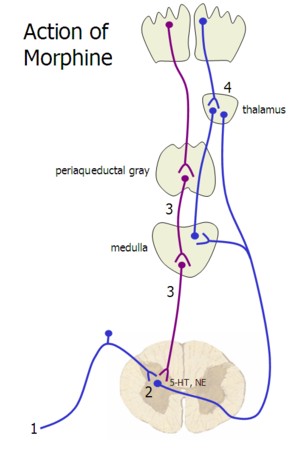
Opioids
last authored: April 2012, David LaPierre
last reviewed:
NOTE: Specific drug dosages are given here; however, do NOT provide care based on this topic without consulting an expert.
Opioids can be lethal if used inappropriately.
Introduction
Opioids are a family of potent medications. Their uses include:
- analgesia for severe pain
- anaesthesia
- treatment of palliative dyspnea
- cough suppression
- antidiarrheal action
Opioids are very effective, their side effects, notably respiratory depression, can be life-threatening. Opioid abuse is also a very common phenomenon. Unfortunately, for these reasons, many health care providers are afraid of them, and many patients experience unnecessary pain.
Opioid Medications
PO (mg) |
IV/SC (mg) |
half-life |
notes |
|
weak |
||||
codeine |
100 |
metabolized to liver; 10% of people do not metabolize |
||
moderate |
||||
oxycodone |
5-7.5 |
|||
strong |
||||
morphine |
10 |
5 |
||
hydromorphone |
2 |
1 |
||
fentanyl patch |
5 mcg/hr |
see dosing information below |
||
methadone |
0.5-1 |
|||
meperidine |
use not recommended due to toxicity |
Fentanyl Transdermal equivalency can be challenging to calculate, and a range is used by various practitioners:
Morphine mg PO in 24 h45-134 135-224 225-314 315-404 405-494 495-584 |
Fentanyl transdermal patch (ug/hr)25 50 75 100 125 150 |
Starting a Patient on Opioids
Most clinicians would begin with one of the following dosage algorithms:
- morphine (5mg po Q4h + 3mg po Q1h prn)
- oxycodone (5 mg po Q4h + 3 mg po Q1h prn)
- hydromorphone (1 mg po Q4h + 0.5-1 mg po Q1h prn)
Most opioids can be given PO, IM, SC, or IV. Use the PO route as possible. In general, the parenteral (IV/SC/IM) route is twice as potent as PO. Time of onset is as follows:
- PO: 45-60 min
- SC: 15 minutes
- IV: 5-10 minutes
Opioids cause predictable nausea and constipation. Accordingly, it is prudent to begin an anti-emetic such as dimenhydrinate or metoclopramide, along with laxatives such as docusate, PEG, and/or senna.
Titrating
If pain is unrelieved, increase dosing by 50%.
Breakthrough dosing is normally given with q1h frequency, and should be eqivalent to 10-20% of the total daily dose. If 3 or more breakthrough doses are being given, the regular dose should be increased.
There is no maximum dose of opioids, whose use is only constrained by their side effects.
When switching opioids, reduce calculated dose by 30% initially.
Long-acting formulations should be used only when patients have reached a stable q4h dosing.
Mechanism of Action

1. Nociceptors
acts peripherally to decrease excitiability of sensory nerves
2. Spinal Cord
- prevents ascending pain transmission by binding presynaptic μ receptors, decreasing calcium influx and preventing vesicle release, especially glutamate
- binds postsynaptic μ receptors, increasing K+ influx and hyperpolarizes post-synaptic neurons
3. Supraspinal Sites
Disinhibition: activates μ receptors on descending GABA-releasing neurons in the periacqueductal gray in the midbrain, inhibiting them and inducing NE and 5-HT-production of pain inhibitory neurons. This leads to spinal block
4. Limbic System
affects emotional experience of pain, causing euphoria
- acts on μ receptors in the CNS;
- fentanyl is inactivated by P450; potent P450 inhibitors should accordingly be used with caution
- metabolized in the liver and excreted through the kidney
- anxiolytic
- reduces sympathetic outflow
- vasodilation reduces cardiac filling pressures
- decreases MV02
- metabolites (which don't cross the BBB) can be stored in muscle
Adverse Effects
Side effects of opioids are frequent. It is important to warn people by saying side effects are to be expected to avoid concerns about allergy. The most common side effects include:
- sedation and CNS depression
- nausea, vomiting
- constipation, urinary retention
- respiratory depression (increased with opioid naivity, rapid escalation, IV drip, kidney impairment/volume depletion, concurrent benzodiazepines or anticholinergics)
- mood changes
- hypotension (arterial vasodilation)
- myoclonus, hyperalgesia/allodynia, delirium, hallucinations
- dry mouth
- pruritis, urticaria (hives)
- biliary colic
Tolerance occurs as repeated administration produce less effect. This can be a problem with chronic pain. Tolerance involves PKC-mediated phosphorylation of the μ receptor.
Physical Dependence involves overactivity of cAMP following long term suppression. Withdrawal produces physical abstinence syndrome. Symptoms can include:
- mild: lacrimation, yawning, sweating
- moderate/severe: anorexia, xramps, nausea, vomiting, restlessness, irritability, tremor, tachycardia, hypertension, chills, spasms, goosbumps
Psychological dependence appears to involve activation of endogenous reward systems.
Addiction, which is a combination of physical and psychological dependence, is described under substance abuse disorders.
